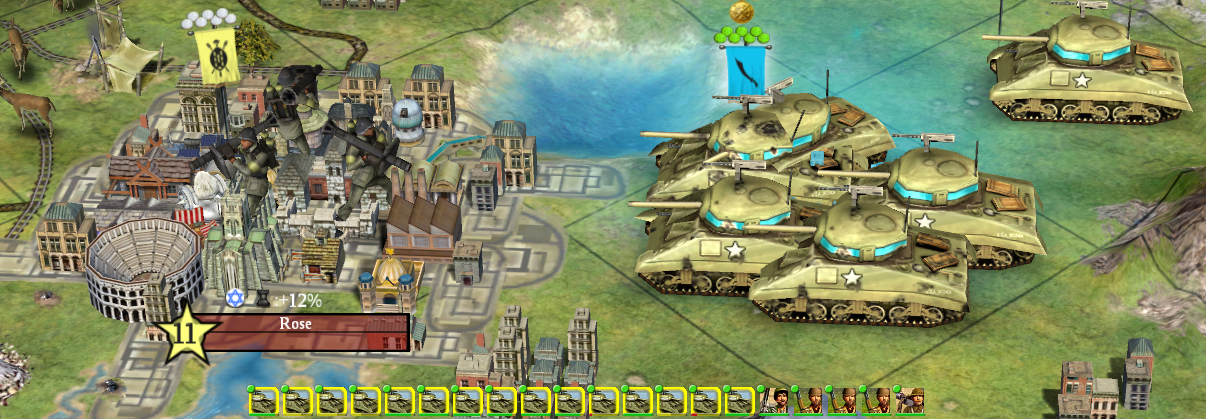Stack Of Doom

This post is about Civilization IV, a computer game that's over fifteen years old, and has had two director successors. As always, I strive to maintain my reputation for tackling topical issues.
First, a recap of the relevant game mechanics. In Civ IV, different types of military units get various bonuses. For example, a spearman gets a bonus against mounted units, so in a battle between a spearman and a chariot, the spearman will usually win. An axeman gets a bonus against melee units, so in a battle between an axeman and a spearman, the axeman will usually win. And a chariot gets a bonus when attacking axemen, forming a nice rock-paper-scissors setup.
Furthermore, you can stack multiple units on the same tile. Every unit still moves and fights individually though. When you attack a stack of units, the unit that has the highest chance of victory will defend. So, say there's a stack consisting of one spearman and one axeman. If you attack it with a chariot, the spearman will defend. If you attack it with a spearman or an axeman, the axeman will defend. As you can see, well-composed stacks of units are difficult to attack.
And there's no limit to the number of units you can have in a stack, so generally, it's most effective to put all of your troops together in one giant stack, making what's called a "Stack of Doom". Unless there's a significant tech difference, the only way to reliably counter a stack of doom is with another stack of doom. This is understandably frustrating, and it can make combat a little bit uninteresting.
Civ V dealt with this problem by introducting "One Unit Per Tile". You can only have one single military unit in a tile. In my opinion, One Unit Per Tile is far worse than Stacks of Doom, both from a gameplay perspective and from a realism perspective. Here's an article that talks about some of the problems with One Unit Per Tile.
Here are my ideas for how to fix Civ IV's Stack of Doom:
- More collateral damage. Typically, when you attack a stack of units, only the one defending unit takes any damage. But some units, like catapults and cannons, and also the Chinese unique unit do collateral damage, which means they can do damage to other units in the stack. My first suggestion is to simply make more units inflict collateral damage, and make collateral damage more harmful.
- More targeting. Targeting is a concept that exists in Civ IV, but is only used by a single unit. The Khmer unique unit is the ballista elephant. Like standard war elephants, it gets a bonus against mounted units, but unlike any other unit in the game it targets mounted units, which means that if it attacks a stack with any mounted units, one of the mounted units will be the defender. My second suggestion is to make more units have this ability.
- Flanking. This is a new concept that doesn't exist in Civ IV. (There is a concept with the same name, but that's just a special version of collateral damage.) The idea is that if you attack an enemy unit, and there's a friendly unit directly adjacent to the enemy, but not on the same tile as the attacker, then the attacker gets a bonus.
- Attacks of Opportunity. This one I'm less confident about. It's another concept that doesn't exist in Civ, but it is related to Zones of Control, a concept that existed in Civ I and II. In those games, if you had a unit that was adjacent to an enemy unit, you could attack or you could retreat, but you couldn't move your unit to another tile that's also adjacent to an enemy unit. It was really restrictive, which I think it why it was removed in later games. My idea here is to reintroduce that, but less restrictively. You can still move around an enemy unit, but doing so would give the enemy an attack of opportunity. In other words, they would get a free shot at your unit, and your unit wouldn't get a shot at them.
All these suggestions are intended to work with Civ IV's existing combat system, but they would require making other changes for balance. The existing units that do collateral damage and targeting would need to be buffed in some way to distinguish them. And since defending a city requires putting a stack of units in it, there would need to be a way of countering these abilities in a city. Perhaps defensive structures like walls and castles could reduce or nullify these abilities. You would probably also need to change the costs, strengths and abilities of various units, and maybe add and remove some.
